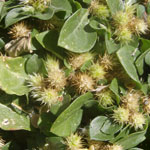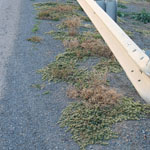Khaki weed
Common name:
- Khaki weed
Scientific name:
- Alternanthera pungens Kunth
Plant status
Catchment management authority boundaries
Regionally prohibited in the North East, East Gippsland, Port Phillip and Western Port catchments.
Regionally controlled in the Wimmera, North Central and Goulburn Broken catchments.
Restricted in the Glenelg Hopkins, Mallee, Corangamite and West Gippsland catchments.
Plant biology
Appearance
Herbaceous plant — Forb (flowering herbaceous plant — not a grass)
Description
Khaki weed is a prostrate, creeping perennial herb and propagates from an underground organ (geophyte).
Stems
Khaki weed stems are reddish in colour. They grow in a prostrate manner and trail to 60cm long. The stems have fine teeth (visible with a microscope) and soft silky hairs.
Several stems grow from each crown with roots formed at stem nodes.
Leaves
Khaki weed has numerous leaves that grow in opposite pairs of unequal size up to 4cm long. They are oval shaped, have short stalks and sparsely haired.
Veins are prominent on the underside of the leaves.
Flowers
Flowers of khaki weed are inconspicuous and surrounded by sharply-pointed, chaff-coloured bracts, occurring in clusters in the axils of the leaves.
Fruit
Fruit is a prickly burr about 1cm long. They are chaff-coloured.
Growth and lifecycle
Method of reproduction and dispersal
Most dispersal occurs when khaki weed's prickly burrs attach to animals, equipment, clothing and tyres. The weed spreads very rapidly along roadsides when cars and vehicles travel on road verges.
Cultivation carries these plants, as well as root fragments, to clean areas where they establish if moisture is adequate.
Rate of growth and spread
Patches can quickly increase in size as new plants form at the stem nodes.
Seedbank propagule persistence
Khaki weed is a prolific seeder. The seeds remain viable for many years.
Preferred habitat
Khaki weed prefers tropical and subtropical regions. The plant grows mainly on light soils in areas with high temperatures.
It is a troublesome weed in rural towns, occurring on nature strips, playing fields, caravan parks and saleyards. It occasionally invades native pastures on sandy soils but usually does not persist.
The plant prefers moist areas for vigorous growth but can tolerate periods of drought due to its deep taproot.
Growth calendar
The icons on the following table represent the times of year for flowering, seeding, germination, the dormancy period of khaki weed and also the optimum time for treatment.
| Jan | Feb | Mar | Apr | May | Jun | Jul | Aug | Sep | Oct | Nov | Dec | |
|---|---|---|---|---|---|---|---|---|---|---|---|---|
| Flowering | ||||||||||||
| Seeding | ||||||||||||
| Germination | ||||||||||||
| Dormancy | ||||||||||||
| Treatment |
Impact
Impact on ecosystems and waterways
Khaki weed occasionally establishes in native pastures where it out-competes other native species. Its presence has a major impact on ground flora.
Agricultural and economic impacts
The seed heads of khaki weed cause damage to the feet and mouths of animals and causes a skin ailment in cattle. The weed is also believed to be poisonous to animals but they rarely eat it.
The plant contributes to vegetable fault in wool.
Social value and health impacts
The sharp spines of khaki weed heads are a great annoyance to bare-footed children and fruit-pickers and may affect some recreational activities. It is known to cause hayfever, asthma and dermatitis in some people.
Management
Prescribed measures for the control of noxious weeds:
- application of a registered herbicide
- cultivation
- physical removal.
Read about prescribed measures for the control of noxious weeds.
Other management techniques
Changes in land use practices and spread prevention may also support khaki weed management after implementing the prescribed measures.